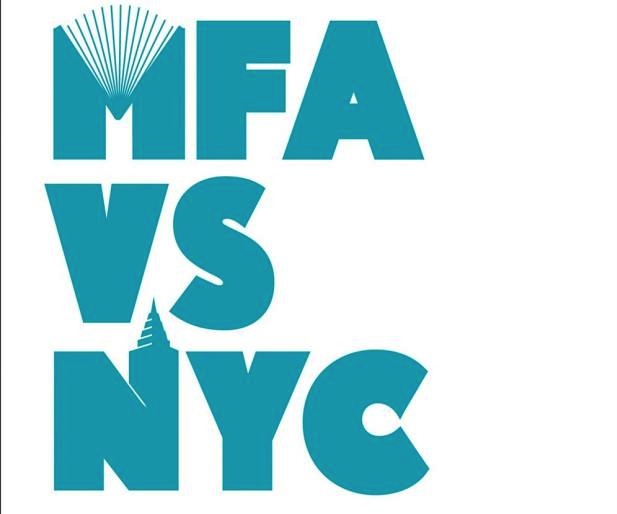Book Review: “MFA vs NYC” — There Are Worlds Elsewhere
The culture of American fiction is never as neatly defined as books like “MFA vs NYC” make it out to be.
MFA vs NYC: The Two Cultures of American Fiction. Edited by Chad Harbach. n+1 / Faber and Faber. 320 pages, $16.00.
by Troy Pozirekides
Chad Harbach’s essay “MFA vs. NYC,” originally published in n+1 Issue 10 (Fall 2010), divided writers (both would-be and working) into two distinct groups. Where the traditional binary applied to writers had been between those with a Masters of Fine Arts degree and those without one, Harbach’s focus was instead “not on the writer’s educational background but on the system within which she earns (or aspires to earn) her living: MFA or NYC.” In one corner, the writer who finds employment as a graduate-level teacher of Creative Writing, he who emphasizes the “primary pedagogical genre form” of the short story, in pursuit of his and his students’ publication in university-backed literary journals. In the other, the writer who goes to New York to conquer Big Publishing, hoping to sell her novel for that coveted six-figure advance. Ring the starting bell.
Two years after the essay’s publication, n+1 and Faber and Faber have put out a book by the same title, bringing together the Harbach original with eighteen new pieces from representatives of both camps. According to the jacket copy, “MFA vs NYC is a must-read for aspiring writers” that will help to answer their most fundamental questions: “Should you seek an advanced degree, or will workshops smother your style? Do you need to move to New York, or will the high cost of living undo you?” As a member of the book’s target demographic of “aspiring writers,” MFA vs NYC seemed an enticing subject for review, especially once I found that much of the debate surrounding the book came from reviewers who were themselves graduates of Creative Writing Programs, people who have an understandably biased agenda of leveling the book’s claims against their own experiences. I came to this book without most of those preconceptions, though I have been in enough undergraduate Creative Writing classes taught by MFAs and MFAs-to-be to have a sense of how these programs work, if only in a trickle-down manner.
The book’s first revelation is (surprise, surprise) that this binary is, by and large, a false one. As Keith Gessen explains in the included essay “Money (2006)”:
Practically no writer exists now who does not intersect at some point with the university system—this is unquestionably the chief sociological fact of modern American literature…Now vast regiments of accredited writers are dispatched in waves to the universities of Tuscon and Houston, Iowa City and Irvine. George Saunders, the great short-story writer and my adviser at Syracuse, told me he knew only two nonteaching writers in his generation (born around 1960): Donald Antrim was one and I forgot the other.
Stories like this are not news to anybody with writerly inclinations. According to D.T. Max, “writing means teaching” was a favorite comment of David Foster Wallace’s to “anyone who would listen” after the publication of his debut novel The Broom of the System. And the growing trend of writers seeking teaching jobs in MFA programs after their own graduations has been well documented in recent books like Mark McGurl’s The Program Era. But has this trend really created, as Harbach’s subtitle asserts, “Two Cultures of American Fiction?”
Mention the idea to any layman, (viz. he or she who reads solely for pleasure, without any interest in writing anything themselves) and you are likely to be met with a blank stare. The majority of the reading public does not have all that much interest in how books come to be, aside from an eager anticipation of a favorite author’s latest release. Zadie Smith’s NW was written while she was teaching at NYU, while Donna Tartt was unharried by university obligations as she wrote The Goldfinch, but most readers will approach the two books in the same way. If they like it, well that’s just great. If not, they’ll put it down — on to the next best thing. And if you are a writer who dreams of Goldfinch-level success, you’d best be aware of the reading public’s pervasive apathy towards this matter.
But this is not a book for the reading public. It is a book for writers, by writers, full of the expected in-jokes, self-effacing witticisms, and existential malaise. Over the course of 300-plus pages, these voices, from the deepest confines of the university to the highest skyscrapers of the New York publishing world, give their honest perspectives on this most amorphous of industries and most vainglorious of dreams: to be published and widely read. At their best, the particulars of these essays are nothing short of fascinating, if painful. Eli S. Evans recounts his “years in the desert” teaching community college part-time while returning to a rented LA warehouse to churn out novel after novel (including a 2,000 page behemoth) that have, to this day, gone unpublished. At their worst, the particulars are puzzling — did I really need to hear, across two separate essays, accounts of the ailments that have befallen Emily Gould and Keith Gessen’s cat, Raffles? (All Middlemarch jokes aside). Such discordance, in both content and tone, ultimately defeats MFA vs NYC’s agenda of offering practical advice to aspiring writers, making the choice between either of the book’s “ Two Cultures of American Fiction” a wash.
Because of its dependence on personal anecdotes in order to flesh out its two-culture argument, the best that MFA vs NYC can offer its “aspiring writers” are tips. These tips, though they are ameliorated by their basis in actual experience, are little better than those of the “professional writers’ ‘trade’ journals” maligned in an included essay by Darryl Lorenzo Wellington:
Tips are not information: they’re suggestions, approaches, repackaged common sense. Tips make no guarantees, and they have no conceivable end…What you see says publishing is all about Winners and Losers. Though tips may mention literary values, the excess reinforces the impression: only the shrewd survive. You’re talented. You know it. Losers play fair, however, and lose. Losers listen to the wrong advice. Winners take everything.
There is a bit of beneficial information within the pages of MFA vs NYC, like Maria Adelmann’s pie charts (yes, pie charts!) of her monthly spending while working in New York and then attending an MFA program at the University of Virginia. But the overall effect of this tract of essays is, ironically, a promotion of the “winners and losers” paradigm that Wellington cautions against. The dream of “being a writer,” which is something wholly different than the actual process of writing, rests on the dreamer’s belief that he will end up, through the monumental force of his own volition, in the camp of winners. Out of the sheer need to survive, he makes his dream into his identity. And it is very hard to dissuade someone from their identity, especially when they believe they are reinforcing it with every stroke of their pen.
Isn’t Chad Harbach, whose own debut novel The Art of Fielding earned him a reported $650,000 advance, a winner? Isn’t Eli S. Evans, try as he may to write that perfect novel, at least so far, a loser? The problem with this binary is that the goalposts for success as a writer, as in any artistic field, are constantly moving. But without them, without the prospect of individual triumph over seemingly insurmountable odds, most people’s dream of “being a writer” would never take shape. This dream, and the winners-and-losers dichotomy it rests upon, however falsely constructed, has been a driving force of American fiction since its birth, from James Fenimore Cooper to Nathaniel Hawthorne to Ernest Hemingway to Norman Mailer and beyond.
In 1960 (when Creative Writing Programs were not yet widespread), Gore Vidal, reviewing Mailer’s Advertisements for Myself for The Nation, wrote:
…writers, each in his own way, are preoccupied with power. Some hope to achieve place through good deportment. Universities are filled with poets and novelists conducting demure and careful lives in imitation of Eliot and Forster and others who through what seems to have been discretion, made it. Outside the universities one finds the buccaneers who mean to seize the crown by force, blunt Bolinbrokes to the Academy’s gentle Richards.
In the ensuing 50 years, as Creative Writing Programs have proliferated, they have only provided more socially acceptable means (salary, benefits, and in special cases, tenure) for writers to make their own power-grabs. The end goal, the dream of being read by millions, and the desire, on some level only quantifiable to the individual, to “win” is still the same, despite whatever employment a writer may seek ad interim.
This is nothing new, and it is not likely to change, no matter how many more freshly-minted MFAs embark on improbable careers as writers, year in and year out. The knockabout culture of American fiction is never as neatly defined as books like MFA vs NYC make it out to be, and its tenor depends just as much on the individual caprice of tastemakers like Oprah Winfrey as it does on “literary merit” (which itself can only be broadly quantified by the tastemakers of the Lit Crit world, people like Michiko Kakutani or James Wood). All that we aspiring writers can do under these turbulent conditions is bear down toward that far-off dream, take the hits, and bless the ride.
Troy Pozirekides is a freelance writer and critic. He divides his time between Boston and Los Angeles, and his writerly pursuits between literary fiction and screenplays. He is also a musician, playing trumpet and guitar. Follow him on Twitter at @tpozirekides.
Tagged: Chad Harbach, Contemporary America fiction, MFA vs NYC: The Two Cultures of American Fiction


